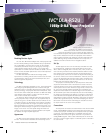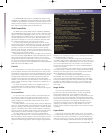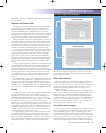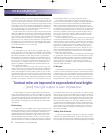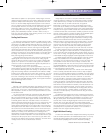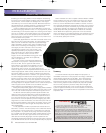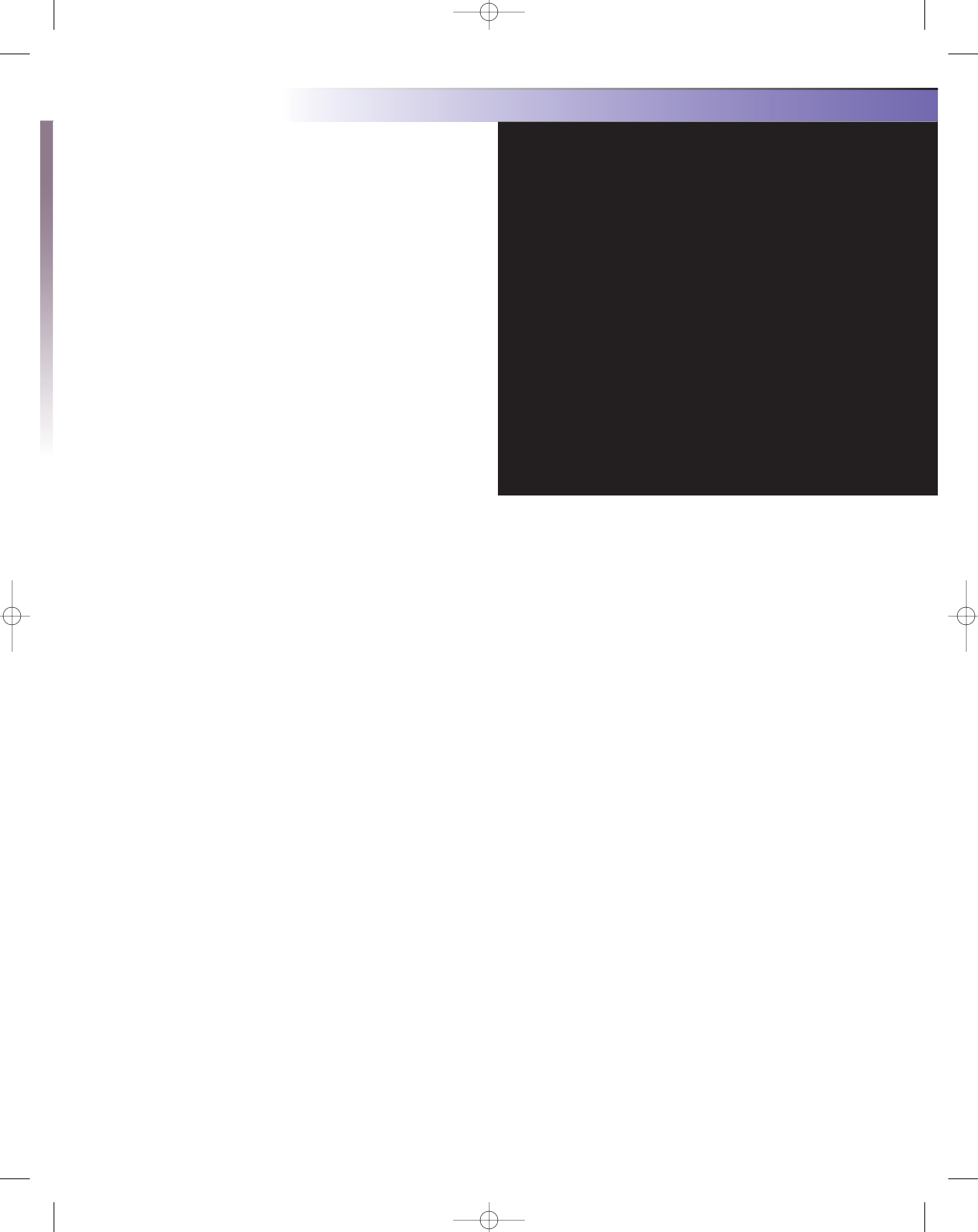
The YPbPr/RGsB analog input is compatible with 480i/p, 576i/p,
720p60/50, and 1080i60/50 video formats. Black-level setup (0 IRE or
7.5 IRE) can be selected for composite and S-video signals, but not
analog component signals. Color decoder selection (ITU Rec. 601 or
Rec. 709) for analog YPbPr signals is automatic only.
HDMI Compatibility
The HDMI inputs accept 480i/p, 576i/p, 720p60/50, 1080i60/50,
and 1080p60/50/24 video signals, and up to 1280 x 1024 (60 Hz) PC
signals. They accept digital RGB, YCbCr 4:4:4, or YCbCr 4:2:2 sig-
nals automatically from HDMI sources, or those signal types can be
manually selected in the on-screen menu. Manual selection of the
signal type is important so a user can override the automatic selec-
tion if there are problems with one type of source signal.
The YCbCr color decoding is automatically set to the ITU Rec.
601 decoding matrix for SD signals and the ITU Rec. 709 decoding
matrix for HD signals. I used an AccuPel HDG-4000 video-signal
generator to verify that the automatic selection worked correctly.
However, there have been numerous source products that produce
the wrong color encoding, so JVC should have also provided manual
selection of the color-decoding matrix.
Digital RGB-Video input levels (black at digital code 16 and refer-
ence white at 235) or digital RGB-PC input levels (black at 0 and ref-
erence white at 255) can be manually selected. They are called
Standard and Enhanced, respectively, in the menu. The menu selec-
tion correctly changes the black level (Brightness) and the gain
(Contrast), so the picture remains calibrated when switching between
RGB-video levels and RGB-PC levels.
Controls
The nearly ideal, 2-inch wide remote control from the earlier pro-
jector is retained. All buttons are illuminated and have easy-to-read
nomenclature on their surfaces. There are dedicated buttons for each
input and each Image Profile. There are rocker buttons for Contrast
and Brightness and buttons to increase and decrease Color and
Sharpness. The remote also has buttons to select Aspect Ratio,
Gamma, Color Temperature, and Test Patterns. There is also an Info
button, a button to blank the image, and buttons to navigate the on-
screen menus.
The top of the projector includes menu-navigation buttons, an
Input selection button, a button to blank the image, and a
Standby/On button. There are also small, non-intrusive warning and
status indicators.
On-screen Menu
The on-screen menu window includes a horizontal title bar with
six submenus: Image, Setup, Source, Install, Function, and Info.
When submenu items with variable levels are selected, they tem-
porarily collapse into a control bar near the bottom of the screen
while being adjusted.
The Image submenu includes Image Adjust (Contrast, Brightness,
Color, Tint, Sharpness, DNR), Color Temperature (Low, Middle, High,
Memory1, Memory2), Gamma (Normal, Theater1, Theater2, Dynamic,
Custom), Offset (Red, Green, Blue), and Pixel Adjust. The latter per-
mits the red, green, and blue image colors to be horizontally and ver-
tically shifted in one-pixel increments, to optimize convergence.
The Setup submenu provides a choice of six Image Profiles
(Cinema, Natural, Dynamic, User 1-3) and the ability to save, clear, or
reset the Profiles to factory settings. There are also submenu items to
select the HDMI input levels (Standard, Enhanced), adjust the hori-
zontal and vertical image position, mask the edges of high-definition
images (0, 2.5, 5 percent), and to turn on or off 2.5 percent overscan
for standard-definition 4:3 signals.
The Sources submenu provides Component Video signal selec-
tion (YPbPr, RGB, SCART), HDMI signal selection (Auto, YCbCr 4:4:4,
YCbCr 4:2:2, RGB), Screen Aspect Ratio (4:3, 16:9, Zoom), V-Stretch
(On, Off), and Film Mode (Auto, Off). V-Stretch is a new feature for
use with an external anamorphic lens. There’s an additional Resize
function for PC signals.
The Sources submenu also includes items to configure the Black
Level setup (0 IRE, 7.5 IRE) for NTSC composite and S-video signals,
and select the color system (Auto, NTSC, NTSC4.43, PAL, PAL-M,
PAL-N, SECAM) for composite or S-video signals.
The Install submenu includes Menu Position (nine locations),
Menu Display (On, 15 seconds), Line (input) Display (Off, 5 sec-
onds), Flip H, Flip V, High-Altitude Mode, Background Color, Sleep
Timer, D-ILA Startup Logo, Lamp Power (Normal, High), Test Pattern
(six patterns), and Language (22 choices). The Info submenu dis-
plays the current input, input source signal format, and total lamp
hours used.
Image Profiles
There are three predefined Image Profiles (Cinema, Natural,
Dynamic) and three User Profiles (User 1-3). Each Image Profile
stores Contrast, Brightness, Color, Sharpness, DNR, Color
Temperature, Gamma, and Offset settings. The Cinema Profile is fac-
tory set to the Low Color Temperature, the Natural and User Profiles
are set to the Middle Color Temperature, and Dynamic Profile is set to
the High Color Temperature. The settings for all profiles can be
changed, but changes to the User Image Profiles are not retained
unless they are explicitly saved. The User Profiles can also be
cleared, and the predefined Image Profiles can be reset to the facto-
ry defaults.
Aspect Ratios
There are only three Aspect Ratio modes—16:9, 4:3, and Zoom.
The Aspect Ratio is fixed at 16:9 for high-definition input signals. The
16:9 mode is also used for 16:9 DVDs. The 4:3 mode displays full-
frame 4:3 pictures in the center of a 16:9 screen with black sidebars.
The Zoom mode displays 4:3 letterboxed frames by expanding the
General
Image Device: three-chip D-ILA
®
(0.7-inch diagonal)
Aspect Ratio: 16:9
Screen Size (16:9): 60 to 200 inches diagonal
Resolution: 1920 x 1080 pixels (16:9) x 3 chips;
Projection Lens: 2.0x zoom lens (1.4:1 – 2.8:1) with power
focus/zoom
Lens shift: (V) ±80 percent, (H) ±34 percent
Input Signals: (Analog) 480i/p, 576i/p, 720p 60/50, 1080i 60/50;
(Digital) 480i/p, 576i/p, 720p 60/50, 1080i 60/50,
1080 24p/60p/50p, VGA/60Hz, SVGA/60Hz, XGA/60Hz,
SXGA/60Hz
Lamp: 200 W UHP (BHL5009-S)
Contrast Ratio: 30,000:1 (without iris)
Input: Composite (1, RCA); S-video (1, Mini DIN);
component
(1, RCA x 3); HDMI (2, 19-pin HDCP compliant)
Serial Control: RS-232C (1, D-sub 9-pin)
Power Requirement: 100 V – 240 V AC, 50/60 Hz
Power Consumption: 280 W (Standby mode: 2.7 W)
Dimensions (WHD In Inches): 17.9 x 6.8 x 16.5
Weight (In Pounds): 25.5
Price: $7,995
Manufactured In Japan By:
JVC Professional Products Company
1700 Valley Road
Wayne, NJ 07470
Phone: 973 317 5000
pro.jvc.com
SPECIFICATIONS
JVC® DLA-RS2U 1080p D-ILA® Front Projector
THE ROGERS REPORT .
Widescreen Review • Issue 129 • March 2008
3
2/7
#129 JVC REPRINT:Layout 1 2/7/08 1:54 PM Page 3



